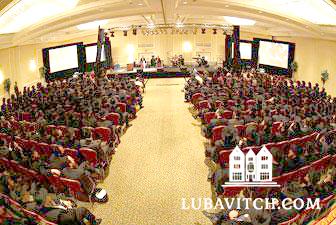Rabbi Adin Steinsaltz likes to tell about the time he had seven projects on his table, and felt he needed to drop some of them. He wanted the Rebbe’s advice on how to prioritize, as he couldn’t possibly work on them all.
“In answer to my dilemma,” said Steinsaltz, his eyes crinkled with delight at this trenchant anecdote, “the Rebbe gave me yet another project.”
If the creative energy of the individual is a reflection of the Divine, it should come as no surprise that the Rebbe saw endless creative potential in the eyes of every human being.
The more they achieved, the more he expected of them. And he demanded this of his shluchim, daring them to accelerate their own personal drive to do more, reach higher, probe deeper, always appreciative of their achievements, never satisfied.
Productive disquiet of this kind is characteristic of Chabad-shluchim and is translated day after day into the wide variety of their activities within disparate and scattered communities everywhere.
Once a year, shluchim are offered a bird’s-eye view of their collective creative output. Once a year, they get to feel the reverberations of their aggregate energy, and see the dazzling mosaic they complete, unveiled for just a few moments before they move on to a new challenge.
In a few days, the 24th International Conference of Chabad Shluchim begins. The temptation to flaunt numbers is hard to resist, especially when the numbers are impressive. Close to 4,000 are expected at the Banquet Dinner of the Conference, which has moved this year yet again, to a larger-capacity venue: Pier 94 on the West Side Highway.
Rabbi Moshe Kotlarsky, Vice Chairman of the Chabad-Lubavitch Merkos L'Inyonei Chinuch at Lubavitch Headquarters, will unwrap plans for the opening of new Chabad Houses in the ever-growing roll call, with names of faraway cities and exotic countries to be added to the map of Chabad. He will announce new educational initiatives, bolder than last years’, that will propel Chabad shluchim on another 12-month sprint to achieve greater gains, setting the bar even higher.
Shluchim will choose from a four day menu of thoughtfully planned and professionally presented sessions. They’ll participate in workshops by leading experts in the entire gamut of community building, education, spiritual and social outreach. They’ll learn new strategies and take home a wealth of new applications.
Yet there’s an introspective dimension to the Conference as well. Shluchim come, they say, to draw and drink from the fountain of their spiritual sustenance. In the courtyard of the Rebbe, the ambient warmth yet inspires those who remember and even those too young to remember. So this year’s conference will dedicate more time to traditional Chasidic study and “farbrengen” type opportunities, with senior shluchim leading.
Rabbi Yehuda Krinsky, Chairman of the educational and social services division at Lubavitch Headquarters and of the Conference, remembers the Rebbe’s holiday mood when Shluchim would come for the Conference. “He took it very much as his simcha; it was to him as a family reunion.” And as family simchas go, the Rebbe was specific about the “family” photograph. He wanted all the Shluchim to be in the photo, and he wanted it taken against the backdrop of Lubavitch Headquarters.
Like a proud father, the Rebbe kept the photos on his desk. “The Rebbe saw the Conference—specifically the unity of the Shluchim, as a potent mass of spiritual energy with the power to move mountains,” Rabbi Krinsky says.
In 1983, Rabbi Manis Friedman, Dean of Bais Chana, the women’s yeshiva based in S. Paul, Minnesota, was one of 70 Chabad representatives in the U.S. who had come for a Shabbos with the Rebbe, the first Conference of Shluchim. It was relatively, an intimate experience; the issues were more local, the program simpler, the presentation unembellished.
Twenty four years later, Friedman says the focus has not changed.
Of course, the numbers have grown, venues outgrown, and the scope of the program is broad, comprehensive and sophisticated. The issues are more complex today, and the challenges more nuanced. But in substance, says Rabbi Friedman, the Conference is still about stock-taking and reexamining the interior landscape of the Chasid, the Shliach.
“It’s about how we answer our indebtedness to the Rebbe,” says Friedman.
How do we return our debt to the Rebbe?
Rabbi Friedman quotes from the statement by the Baal Shem Tov promising that redemption will follow when certain mystical unifications are achieved.
It’s not about letters and numbers and mystical configurations.
It’s about integrating the love of G-d, of Torah and of the Jewish soul, in every dimension of life, he explains.
“It’s about learning to look at a Jew the way the Rebbe did; to value what is precious and Divine in every individual.”
The possibilities thus become truly endless.
And the Conference in the courtyard of the Rebbe becomes an occasion for celebration.

Be the first to write a comment.